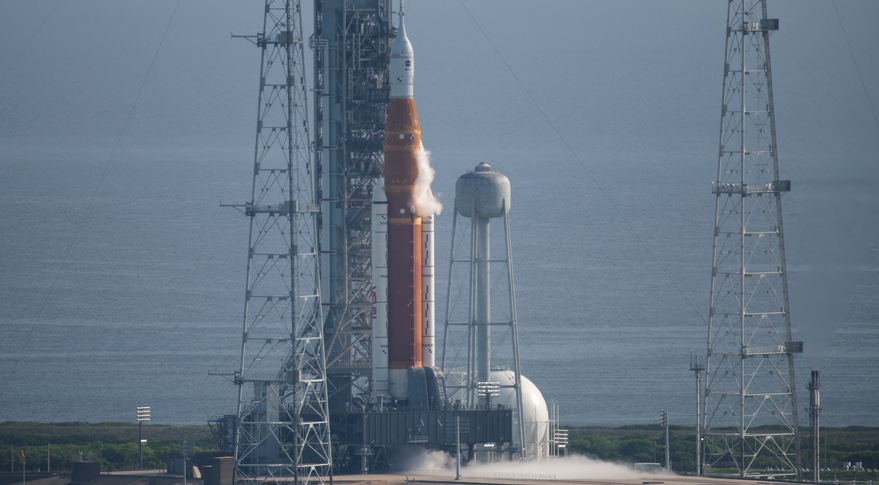Products You May Like
Updated 12:25 p.m. Eastern with Nelson comments.
KENNEDY SPACE CENTER, Fla. — NASA called off a second attempt to conduct the inaugural launch of the Space Launch System Sept. 3 after failing to resolve a liquid hydrogen leak during fueling of the rocket, potentially delaying the mission until October.
NASA scrubbed the launch, which had been scheduled for a two-hour window that opened at 2:17 p.m. Eastern from Launch Complex 39B here, three hours before the window opened. Mission managers concluded that they had run out of time to fix a liquid hydrogen leak detected hours earlier.
Controllers noticed a leak in a quick-disconnect fitting for a liquid hydrogen line into the core stage of the SLS shortly after fueling of the core stage started. The connection is different than one that leaked in the first launch attempt, and had not shown signs of leaks in either the first launch attempt or earlier countdown rehearsals. Engineers made several attempts to reseat the fitting, first by allowing it to warm up and then start flowing liquid hydrogen into it again, believing the temperature change would seal it into place again. It did not work.
A second technique involved stopping hydrogen flow and closing a valve, then using pressure from helium in ground systems to force the fitting back into place. That also did not work, as did a second attempt to warm and then cool the fitting.
Officials did not immediately announce a new launch date. The next launch opportunities are Sept. 5 and 6, after which the current launch period closes and NASA would have to wait until at least late September to try again. A 90-minute launch window opens at 5:12 p.m. Eastern Sept. 5 and a 24-minute window opens at 6:57 p.m. Eastern Sept. 6.
In comments on NASA TV about an hour after the scrub, NASA Administrator Bill Nelson said the mission management team will meet later in the day discuss whether the vehicle needs to roll back to the Vehicle Assembly Building (VAB) for repairs. “If they decide that’s the case, then it’ll be an October launch,” he said, referring to a launch period that is open from Oct. 17 to 31.
“We’ll go when it’s ready. We don’t go until then, especially now on a test flight,” he added, praising the launch team for their efforts. “They do it right. They do it by the book.”
NASA scrubbed its first attempt to launch the rocket Aug. 29 when sensors indicated that one of four RS-25 engines in the core stage had not chilled to the required temperature during a “hydrogen kickstart” procedure that was not tested during four wet dress rehearsals of the countdown in April and June. Several efforts to lower the engine’s temperature failed.
Engineers later concluded the anomalously high temperature was the result of a faulty sensor and that other data showed the engine had, in fact, cooled to the proper temperature. Controllers planned to ignore that sensor and use the other data to confirm the engines cooled.
“We’ve had time to go back and look at the data and compare many sources of data, and do some independent analysis that confirmed it’s a bad sensor and we’re getting good quality propellant through the engine,” John Honeycutt, NASA SLS program manager, said at a Sept. 1 briefing.
The agency went into the second launch attempt with more confidence about a launch based on the experience from the earlier launch attempt and the previous rehearsals. “We looked the team in the eye. They’re ready,” Jeremy Parsons, deputy manager of NASA’s Exploration Ground Systems program, said of the launch team at a Sept. 2 briefing. “They are getting better with every attempt and actually performed superbly during launch countdown #1.”
“This is a test flight,” he added. “There is risk that we’ll not be able to get off.”
